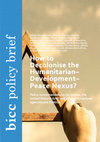Peer-reviewed articles by Esther Meininghaus

Small Wars & Insurgencies, 2024
Precision strikes from a distance are a common practice of state warfare.
However, the global pro... more Precision strikes from a distance are a common practice of state warfare.
However, the global proliferation of precision strike technologies, like missiles
and armed drones, makes such weapons progressively available to non-state
armed groups (NSAGs). We look at Daesh in Syria and Iraq and at the Houthis in
Yemen as two case studies to analyse the consequences of this proliferation for
non-state warfare. Our focus is the socio-spatial dimension of warfare. We probe to what extent precision strike technology is used to conquer and control territory (solid warfare) or to weaken the enemy network without territorial
ambition (liquid warfare). The predominant view in the literature on NSAGs
perceives them as would-be state builders who desire to govern and hence, seek to control territory. Our findings support this view, as both Daesh and the Houthis have applied precision strike technologies for solid warfare. However, at the same time, both groups have used these weapons for liquid warfare, too, targeting in particular civilians and civilian infrastructure to weaken the network´of their enemies. This poses new questions to scholars of small wars and insurgencies and calls upon policy makers to increase efforts to curb the proliferation of precision strike technologies.

ISIM Working Papers, 2023
This working paper provides empirically supported background on the possibilities and risks of re... more This working paper provides empirically supported background on the possibilities and risks of return and reintegration of refugees to Syria. Based on recent qualitative interviews, it differentiates between the experiences of refugees returning to regime-controlled areas mainly in Southern, Central and Western Syria from Lebanon and Jordan as well as those returning from Turkey and Northern Iraq to Northern Syria. It addresses three major challenges to the return of refugees: (1) the lack of security and safety; (2) the humanitarian and socioeconomic situation, threatening the survival of returnees; and (3) severe challenges in accessing housing, land, and the property rights. The paper provides an overview of the reasons for ongoing spontaneous returns, the official rhetoric of host countries and their ad hoc procedures and practices. As a key message, the paper stresses that despite an end to warfare in most areas, safe return remains unattainable because the Syrian regime and other military actors continue to pose severe threats to the lives and survival of Syrians including returnees.
Versöhnung : Theorie und Empirie [Reconciliation: Theory and Empirics], 2023

Journal of Negotiation, 2021
This article argues for a new local turn in peace process research to analyze the perspectives an... more This article argues for a new local turn in peace process research to analyze the perspectives and local embeddedness of peace process participants in Track One negotiations. Historically, peace process research and practice have focused on mediators' strategies for coaxing belligerent disputants into signing agreements. Problems with the implementation of such agreements (i.e., peacebuilding and peacekeeping) are often faulted as the reason for their collapse. However, statistical data points in another direction and raises the following question: To what extent are the setup and understanding of peace processes themselves (i.e., peacemaking) implicated in the failure of peace agreements? This article highlights how the different experiences with which peace process participants enter negotiations, and the ways in which they operate at the "local" level in addition to the international diplomatic level, have remained largely unexplored for Track One negotiations. Offering a model that understands peace processes as intersecting, oftentimes informal networks, the article

International Peacekeeping, 2020
Stabilization is a contestable concept of intervention in violent conflicts. Often, it is either ... more Stabilization is a contestable concept of intervention in violent conflicts. Often, it is either uncritically supported or rejected. In this article, we criticize current conceptualisations and practices of stabilization and newly introduce a dynamic approach for stabilization that yields a transformative potential. By distinguishing static vs. dynamic approaches to stabilization, we address the widespread dilemma that so-called stabilization measures seem unable to avoid instability and protracted violence in the long-term. Our analysis of the three policy fields peacekeeping, train & equip programmes and migration management in Mali reveals the dominance of static elements in stabilization practice. Instead, our article proposes to see a transformative variant of stabilization measures that enhances long-term security and development. We argue that there are two dynamic approaches of stabilization that policy-makers and practitioners can apply in (post-)conflict societies: state-centred liberal peacebuilding that takes its normative core seriously, and non-state centric peacebuilding that acknowledges alternative lived orders.

Small Wars & Insurgencies, 2020
Current research on civil war neglects the effect of translocal ties on the mobilization of fight... more Current research on civil war neglects the effect of translocal ties on the mobilization of fighters in armed groups (AGs). Yet the Syrian war demonstrates the necessity to pay close attention to this twofold process: Analysing YPG, Hizballah and FSA networks, we argue that AGs are more likely to persist and avoid fragmentation in the long-term if they maintain strong linkages with local communities (local anchoring) and functioning linkages across different localities. We introduce here the concept of translocality to war studies, differentiating it from transnationalism. This analytical lens enables us to focus on localities within Syria, which can influence an actor’s power position in war decisively, while also being subjected to drastic change by AGs. We conclude that translocality offers insights for the study of civil war as it enables us to grasp the embedding of armed groups – or lack thereof – in local communities; differentiating between actor groups depending on their local anchoring, and observing network dynamics between different localities.
This is an Author’s Original Manuscript of an article published by Taylor & Francis in Small Wars & Insurgencies on 13 Apr 2020, available online https://www.tandfonline.com/doi/full/10.1080/09592318.2020.1726568
Contemporary Levant, 2016
This article analyses the dire state of the health system in war-torn Syria. It investigates the ... more This article analyses the dire state of the health system in war-torn Syria. It investigates the drastic changes that have transpired in health provisions since the beginning of the conflict and sheds light on emerging coping mechanisms. The article traces the militarisation of medical care and outlines the severe imbalances created in the provision of medical aid between different parts of the country. Independent of the political or
military outcome of the present war, this article recommends an integrative approach towards health system recovery which is primarily anchored in the experience of those who continue to maintain medical care across the country.
This article argues that humanitarian aid in intra-state conflict plays a crucial but largely unr... more This article argues that humanitarian aid in intra-state conflict plays a crucial but largely unrecognised role in shaping the preconditions for negotiations for peace and post-conflict reconstruction. Drawing on a spatial theory approach, it identifies the role of humanitarian aid as not being temporary and independent, but as forming an integral part of the daily lives of local communities and of continuously evolving structures of governance during conflict. As a result, significant imbalances in the distribution of aid between different geographical areas, as highlighted in the current Syrian war, threaten not only the immediate survival of civilians, but also their future.
Papers by Esther Meininghaus

Sinjar, a district of significance due to the Yazidi genocide and ongoing struggles with armed gr... more Sinjar, a district of significance due to the Yazidi genocide and ongoing struggles with armed groups, land conflicts, and the legal status of women, remains a microcosm of Iraq’s broader challenges. This paper delves into these complex issues, offering a nuanced understanding of local conflicts, their interconnections, and visions for peace rooted in the perspectives of residents and internally displaced persons (IDPs).
The study identifies four major conflict areas:
Safety and Armed Groups: The presence of competing armed groups, impunity, and illicit activities have perpetuated insecurity. Recruitment into these groups often stems from economic desperation.
Impunity for Atrocities: Crimes committed by Daesh (ISIS) and al-Qaeda remain largely unprosecuted, exacerbating trauma and undermining justice for Yazidi survivors and others affected.
Land and Property Disputes: Decades of forced displacement and contested ownership hinder return and recovery efforts for displaced populations, particularly Yazidis.
Status of Women and Children: The return of Yazidi women and children abducted by Daesh faces societal stigma, legal challenges, and lack of social acceptance.
These conflicts are shown to be deeply interconnected, transcending simplistic ethnic or sectarian narratives.
The paper critiques the limitations of local conflict resolution mechanisms, such as ṣulḥ (tribal mediation), which often exclude women and fail to address larger systemic issues. Similarly, the judicial system is marred by corruption and bias, leaving survivors without avenues for justice and accountability.
Despite these challenges, local visions for peace emphasize the need for political solutions, security reforms, and reconciliation. The paper highlights the potential of the 2020 Sinjar Agreement, which aims to address governance and armed group withdrawal, though its implementation has been hindered. Residents stress the importance of addressing trauma, restoring trust, and ensuring inclusive recovery efforts.
With actionable recommendations for legal reform, livelihood support, and reconciliation, this analysis provides a roadmap for aid actors and policymakers to address Sinjar’s unique challenges while fostering a foundation for lasting peace.

Policy Brief, 2024
Increase the ratio and decision-making power of local staff in UN agencies, international agencie... more Increase the ratio and decision-making power of local staff in UN agencies, international agencies and non-governmental UN agencies, international agencies and non-governmental organisations (INGOs) organisations (INGOs) UN agencies and INGOs should employ qualified local staff as a rule and expatriates only in UN agencies and INGOs should employ qualified local staff as a rule and expatriates only in exceptional cases. Qualified local staff should occupy leadership positions at the local, national, exceptional cases. Qualified local staff should occupy leadership positions at the local, national, regional and HQ/global levels. As much value should be placed on knowledge of the context, regional and HQ/global levels. As much value should be placed on knowledge of the context, social practices and local languages as on technical expertise. social practices and local languages as on technical expertise. 2 2 Initiate processes of individual and collective reflection within Initiate processes of individual and collective reflection within organisations to overcome prejudices and structural racism organisations to overcome prejudices and structural racism Local staff in (I)NGOs or UN agencies are often seen as less capable and more corrupt, while Local staff in (I)NGOs or UN agencies are often seen as less capable and more corrupt, while expatriates are seen to be more capable and neutral. Nationality, ethnicity or religion do not expatriates are seen to be more capable and neutral. Nationality, ethnicity or religion do not determine capacity and corruption. Organisations need to initiate processes of reflection on the determine capacity and corruption. Organisations need to initiate processes of reflection on the structural racism behind such assumptions (e.g. one-to-one dialogues, externally facilitated structural racism behind such assumptions (e.g. one-to-one dialogues, externally facilitated sessions) and establish tangible audit mechanisms on diversity, equity, and inclusion. sessions) and establish tangible audit mechanisms on diversity, equity, and inclusion.
Iraq as a UN-driven, in Iraq as a UN-driven, top-down approach. top-down approach. Localisation m... more Iraq as a UN-driven, in Iraq as a UN-driven, top-down approach. top-down approach. Localisation must mean Localisation must mean prioritising the prioritising the knowledge, needs and knowledge, needs and capacities of Iraqi capacities of Iraqi actors and communities. actors and communities.
The HDP nexus approach has The HDP nexus approach has so far failed to deliver on the so far fail... more The HDP nexus approach has The HDP nexus approach has so far failed to deliver on the so far failed to deliver on the promise of a bottom-up promise of a bottom-up approach. We discuss why. approach. We discuss why. A localisation approach runs A localisation approach runs the risk of reproducing existing the risk of reproducing existing power imbalances rather than power imbalances rather than overcoming them. overcoming them.
Causes of Flight »Made in Europe« On European Policy and Its Relationship with Migration and Flight, 2016

BICC Policy Brief 3/2021, 2021
In this Policy Brief, we present lessons learnt and sub-sequent policy implications from an in-de... more In this Policy Brief, we present lessons learnt and sub-sequent policy implications from an in-depth analysis of the UN peace processes on Afghanistan and Syria. We argue that in both processes, the ability of peace process participants who come from Afghanistan and Syria to politically participate in their respective process was and is severely limited, thus hindering the prospects of successful conflict transformation. By political participation, we mean that peace process participants not only attend negotiations (“are being included”) but are in a position to (co-) determine who is negotiating the agreement (incl. which representation mechanism is adequate), what is the format of peace-making (incl. methods of consultation), and what are the issues negotiated in which order (agenda-setting). We call this ‘meaningful political participation’. Emphasising “inclusivity” in peace processes over meaningful political participation is highly problematic for potential progress towards l...

2/2021, 2021
Policy recommendations \ Launch new funding formats to support self-determined civic engagement f... more Policy recommendations \ Launch new funding formats to support self-determined civic engagement for peace GFFO, BMZ, MoI and state governments should provide decentralised funding through civic education institutions (political foundations, bpb, lpbs, ifa) for two types of addressees conducting civic education for peace programmes: Civic and peace education organisations and direct funding for Syrian-and Afghan-led initiatives. They should provide longer-term project funding, funding for independent initiatives, funding to rent meeting spaces and support unbureaucratic and transparent funding application processes. The GFFO should consider providing funding in addition to existing funding lines by the MoI to join expertise on civic education (MoI) and peace support (GFFO). \ Link Afghan and Syrian civic education for peace initiatives in Germany to peace processes The GFFO should act as a facilitator in linking Afghanand Syrian-led peacemaking initiatives in Germany with official track 1, 2 and 3 peace processes mediated by bodies like the United Nations (participation, advisory roles). \ Engage refugees and migrants as peace advocates German policymakers-especially of the German Federal Foreign Office (GFFO), the Federal Ministries of Economic Cooperation and Development (BMZ) and of the Interior (MoI), and federal states-and educational organisations should draw upon the engagement of refugees and migrants from Afghanistan and Syria as agents of change who have a positive influence on peace processes.
In 1973, Daud Khan amended the 1964 constitution and ruled by governmental decrees until the prom... more In 1973, Daud Khan amended the 1964 constitution and ruled by governmental decrees until the promulgation of the 1977 7 The Afghan family law is in fact mainly constituted of Islamic law. See SCHNEIDER, I.: "Recent Developments in Afghan Family Law: Research Aspects", in: Asien 104 (2007), pp. 106-118. 8 I would like to thank Dr. C. Schetter and Prof. Dr. Conermann for their supervision and assistance during the process of writing this paper as well as M. Martens for his proofreading .
German Peace Report 2018, chapter 1: German Stabilisation Policy and Armed Conflict. Analysis of ... more German Peace Report 2018, chapter 1: German Stabilisation Policy and Armed Conflict. Analysis of German stabilisation policy for the year 2017 (focus: Mali, Afghanistan, Iraq; in German).











Uploads
Peer-reviewed articles by Esther Meininghaus
However, the global proliferation of precision strike technologies, like missiles
and armed drones, makes such weapons progressively available to non-state
armed groups (NSAGs). We look at Daesh in Syria and Iraq and at the Houthis in
Yemen as two case studies to analyse the consequences of this proliferation for
non-state warfare. Our focus is the socio-spatial dimension of warfare. We probe to what extent precision strike technology is used to conquer and control territory (solid warfare) or to weaken the enemy network without territorial
ambition (liquid warfare). The predominant view in the literature on NSAGs
perceives them as would-be state builders who desire to govern and hence, seek to control territory. Our findings support this view, as both Daesh and the Houthis have applied precision strike technologies for solid warfare. However, at the same time, both groups have used these weapons for liquid warfare, too, targeting in particular civilians and civilian infrastructure to weaken the network´of their enemies. This poses new questions to scholars of small wars and insurgencies and calls upon policy makers to increase efforts to curb the proliferation of precision strike technologies.
This is an Author’s Original Manuscript of an article published by Taylor & Francis in Small Wars & Insurgencies on 13 Apr 2020, available online https://www.tandfonline.com/doi/full/10.1080/09592318.2020.1726568
military outcome of the present war, this article recommends an integrative approach towards health system recovery which is primarily anchored in the experience of those who continue to maintain medical care across the country.
Papers by Esther Meininghaus
The study identifies four major conflict areas:
Safety and Armed Groups: The presence of competing armed groups, impunity, and illicit activities have perpetuated insecurity. Recruitment into these groups often stems from economic desperation.
Impunity for Atrocities: Crimes committed by Daesh (ISIS) and al-Qaeda remain largely unprosecuted, exacerbating trauma and undermining justice for Yazidi survivors and others affected.
Land and Property Disputes: Decades of forced displacement and contested ownership hinder return and recovery efforts for displaced populations, particularly Yazidis.
Status of Women and Children: The return of Yazidi women and children abducted by Daesh faces societal stigma, legal challenges, and lack of social acceptance.
These conflicts are shown to be deeply interconnected, transcending simplistic ethnic or sectarian narratives.
The paper critiques the limitations of local conflict resolution mechanisms, such as ṣulḥ (tribal mediation), which often exclude women and fail to address larger systemic issues. Similarly, the judicial system is marred by corruption and bias, leaving survivors without avenues for justice and accountability.
Despite these challenges, local visions for peace emphasize the need for political solutions, security reforms, and reconciliation. The paper highlights the potential of the 2020 Sinjar Agreement, which aims to address governance and armed group withdrawal, though its implementation has been hindered. Residents stress the importance of addressing trauma, restoring trust, and ensuring inclusive recovery efforts.
With actionable recommendations for legal reform, livelihood support, and reconciliation, this analysis provides a roadmap for aid actors and policymakers to address Sinjar’s unique challenges while fostering a foundation for lasting peace.
However, the global proliferation of precision strike technologies, like missiles
and armed drones, makes such weapons progressively available to non-state
armed groups (NSAGs). We look at Daesh in Syria and Iraq and at the Houthis in
Yemen as two case studies to analyse the consequences of this proliferation for
non-state warfare. Our focus is the socio-spatial dimension of warfare. We probe to what extent precision strike technology is used to conquer and control territory (solid warfare) or to weaken the enemy network without territorial
ambition (liquid warfare). The predominant view in the literature on NSAGs
perceives them as would-be state builders who desire to govern and hence, seek to control territory. Our findings support this view, as both Daesh and the Houthis have applied precision strike technologies for solid warfare. However, at the same time, both groups have used these weapons for liquid warfare, too, targeting in particular civilians and civilian infrastructure to weaken the network´of their enemies. This poses new questions to scholars of small wars and insurgencies and calls upon policy makers to increase efforts to curb the proliferation of precision strike technologies.
This is an Author’s Original Manuscript of an article published by Taylor & Francis in Small Wars & Insurgencies on 13 Apr 2020, available online https://www.tandfonline.com/doi/full/10.1080/09592318.2020.1726568
military outcome of the present war, this article recommends an integrative approach towards health system recovery which is primarily anchored in the experience of those who continue to maintain medical care across the country.
The study identifies four major conflict areas:
Safety and Armed Groups: The presence of competing armed groups, impunity, and illicit activities have perpetuated insecurity. Recruitment into these groups often stems from economic desperation.
Impunity for Atrocities: Crimes committed by Daesh (ISIS) and al-Qaeda remain largely unprosecuted, exacerbating trauma and undermining justice for Yazidi survivors and others affected.
Land and Property Disputes: Decades of forced displacement and contested ownership hinder return and recovery efforts for displaced populations, particularly Yazidis.
Status of Women and Children: The return of Yazidi women and children abducted by Daesh faces societal stigma, legal challenges, and lack of social acceptance.
These conflicts are shown to be deeply interconnected, transcending simplistic ethnic or sectarian narratives.
The paper critiques the limitations of local conflict resolution mechanisms, such as ṣulḥ (tribal mediation), which often exclude women and fail to address larger systemic issues. Similarly, the judicial system is marred by corruption and bias, leaving survivors without avenues for justice and accountability.
Despite these challenges, local visions for peace emphasize the need for political solutions, security reforms, and reconciliation. The paper highlights the potential of the 2020 Sinjar Agreement, which aims to address governance and armed group withdrawal, though its implementation has been hindered. Residents stress the importance of addressing trauma, restoring trust, and ensuring inclusive recovery efforts.
With actionable recommendations for legal reform, livelihood support, and reconciliation, this analysis provides a roadmap for aid actors and policymakers to address Sinjar’s unique challenges while fostering a foundation for lasting peace.